Common Spiders Found Around Homes and Buildings
ENTFACT-622: Common Spiders Found Around Homes & Buildings | Download PDF | En Español
by Lee Townsend and Ken Yeargan
University of Kentucky College of Agriculture
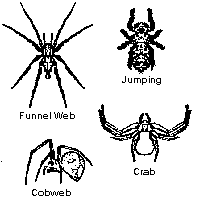
Common Spiders
Spiders tend to evoke two images - webs and bites. Webs are often associated with abandoned, neglected, or haunted houses, while the animals themselves bring to mind the image of a painful or deadly bite. The immediate question - "Is this a black widow or brown recluse?"
Spiders are abundant (over 1,000,000 individuals per acre in a grassy field) and can be found almost anywhere from the bedroom closet to the 22,000 foot level on Mt. Everest. There are about 2,500 different species in North America. Some live in holes in the ground while others may be found under rocks or logs. Those that prefer dark, shaded areas may also occur in cellars and basements. These species may become established in homes.
Most spiders found in homes and buildings are "accidental invaders" that have entered around doors, windows, or other openings. Homes in wooded areas or with naturalized or landscaped foundations may be prone to more frequent invasion because the surroundings are ideal spider habitats.
Spiders are beneficial, feeding mostly on small insects and other arthropods. Some trap their prey in webs or snares; others are active hunters that use excellent vision to stalk or ambush their food. Virtually all spiders have poison glands that connect with the fangs. Venom produced by the glands apparently is used to kill or paralyze prey and in defense. Only a few species, such as the black widow and the brown recluse, have venom that is very toxic or harmful to humans.
Most species do not attempt to bite; many have fangs that are not capable of piercing the skin. However, some will, with results that are similar to a wasp or bee sting. There is the chance that a person can have an allergic reaction to the venom.
Common Kentucky Spiders
Wolf Spiders
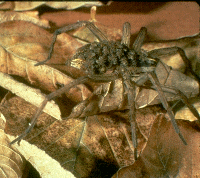
Wolf Spider
Wolf Spiders or ground spiders are common. Most are dark brown. Wolf spiders actively hunt prey and do not use snares or webs. They inhabit grassy or leaf-covered areas and may be active during the day or at night. The female carries an egg sac on her rear end and the young ride on her back for a time after hatch.
They look fierce and their rapid movements make them seem aggressive. They have strong fangs and could bite if disturbed or pinched. Wolf spiders do not persist indoors but are common "accidental invaders".
Funnel Web Spiders
Funnel Web Spiders (Agelenidae) or grass spiders resemble wolf spiders but have a pair of long, distinctive silk spinning tubes at the rear of the abdomen. They build a horizontal, sheet-like web that has a funnel shaped retreat. These webs are most obvious when covered with dew in the morning. The spiders live in shrubbery, grass, under rocks or in debris and seldom come indoors.
Fishing Spiders
Fishing Spiders (Pisauridae), active hunters, are among the largest spiders in the eastern United States. They prefer moist habitats, such as around streams or other bodies of water, but may be found in basements or other damp parts of buildings. They have the typical dark markings of a wolf spider.
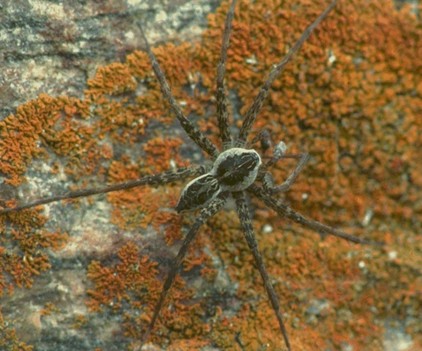
Fishing Spider

Jumping Spider
Jumping Spiders
(Salticidae) have a distinctive body shape and short, strong front legs; many are brightly colored or iridescent. Two very large eyes on the front of the head give them the best vision of all spiders. They slowly stalk their prey and make a sudden pounce from a short distance. Salticids occasionally wander indoors and may overwinter there.
Crab Spiders
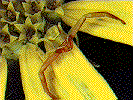
Crab Spider
Crab Spiders (Thomisidae) have two long front pairs of legs. They wait in ambush for insect prey on plants, flowers, tree trunks or soil litter. They rarely enter buildings and do not persist indoors.
Sac Spiders
Sac Spiders (Clubionidae) live on foliage or in the ground. They build tubular retreats under stones, or in rolled leaves or folds of grasses. A pale yellow to pale green species that spins silken tubes among the leaves of shrubbery can give a painful bite.
Cellar Spiders
Cellar Spiders (Pholcidae) with long, thin legs build sheetlike or irregular webs in dark places. They commonly hang upside down under the web.
Orb Weavers
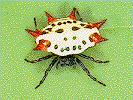
Orb Weaver
Orb Weavers (Araneidae) include "garden spiders" and their relatives. They weave classical, sheet-like orb webs that consist of rays and spirals of silk. They have poor eyesight and have trouble walking on anything but webs. They rarely occur indoors but frequently live on or near the outer walls of buildings. Two spectacular members of the group are the large black and yellow garden spider and the marbled spider with a yellow-orange abdomen that has brown to purple markings. The former tends to build webs in open, sunny places in gardens around houses and in tall grass; the latter prefers wooded areas between trees and shrubs. Some members of the family, known as the spiny-bellied spiders, have thorn-like projections on the abdomen. They usually dwell in wooded areas.
Cobweb Spiders
Cobweb Spiders (Theridiidae) build irregular cobwebs inside and outdoors and tend to hang upside down from them. The webs are build in protected places, sometimes in buildings. Typically, they have a spherical abdomen. The house spider frequently lives in buildings, typically locating its web in the corners of rooms or in the angles of windows. The black widow is a member of this family. A row of small bristles on the hind legs is used to help wrap the spider's prey in silk. As a result, this group is also known as "comb-footed" spiders.
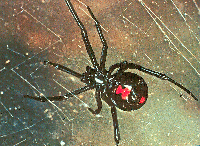
Black Widow Spider
Brown Spiders
Brown Spiders (Loxoscelidae) are also known as the recluse spiders. The best known and most notorious member of this family is the brown recluse that has a violin-shaped pattern on the back of the front body segment. These spiders have only 6 eyes, while other spiders have 8. They construct a sticky sheet of silk that helps trap their prey.
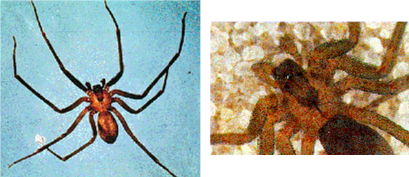
Brown recluse spider (left photo by M. Johnson, University of Kentucky Entomology)
and close-up, showing fiddle pattern (right photo courtesy University of Florida)
The bite of a brown recluse is serious. It is associated with tissue destruction and may require surgical treatment. Read more about Brown Recluse spiders and in ENTFact-631: Brown Recluse Spider.
Revised: 1/94
CAUTION! Pesticide recommendations in this publication are registered for use in Kentucky, USA ONLY! The use of some products may not be legal in your state or country. Please check with your local county agent or regulatory official before using any pesticide mentioned in this publication.
Of course, ALWAYS READ AND FOLLOW LABEL DIRECTIONS FOR SAFE USE OF ANY PESTICIDE!
Images: R. Bessin, University of Kentucky Entomology, except Crab Spider and Brown Recluse close-up: University of Florida and Black Widow: USDA Insect and Plant Disease Slide Set
